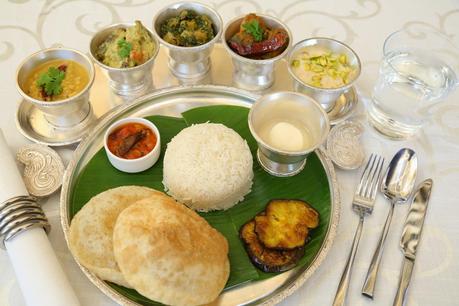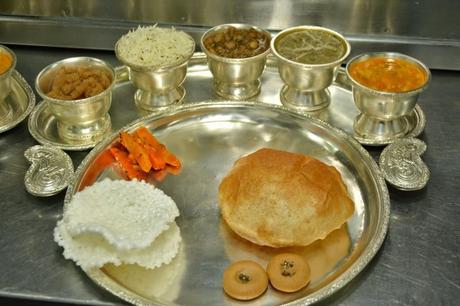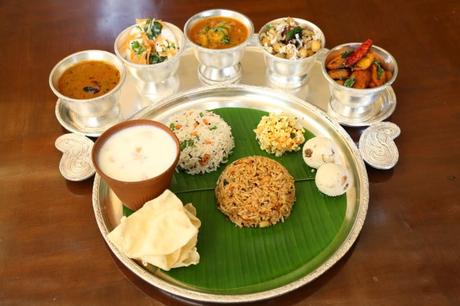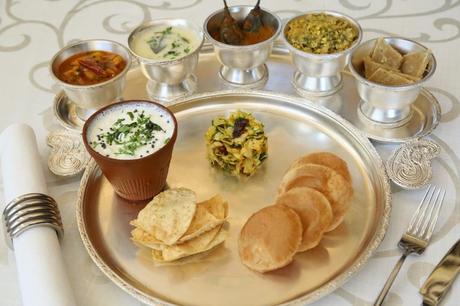
East India Bhog Thali
I am sure many of you will be able to relate to my childhood love that I am going to share here. I used to eagerly wait for Tuesdays as my parents would perform traditional puja and as Prasad I would wait to eat chapatti made of jaggery wheat flour. Despite being a hard-core non-vegetarian I have special space in my heart(read stomach :D) for prasads.A devotee asked his guru, Why do we offer prasad to God ? The wise guru explained, “When we cook food, we cook it not for our pleasure but for the pleasure of the Lord. In Bhagavad Gita, Krishna says that if we offer Him even a leaf, a flower, fruit or water, with love and devotion – He eats it. When the Lord eats the food offered to Him, it becomes Prasadam – a sacrament. This is the reason the sacred food always tastes special, unique and resonates and connects with our spirituality!
I always was excited for Durga puja as our Bengali family friends would frequently wait for arrival of Ma durga.The onset of mahalaya would set the ground and the most awaited during the Puja was the bhog that I would wait eagerly- starting “Shashti”. We used to visit Kali bari and they would offer bhog twice a day. I wouldn’t have to stand in the long queue as my friends had access to kitchen and I used to relish the kheechuri and chorchori – the divine taste that still rejuvenates my soul each time whenever I have it even today! I guess my love for Durga Puja and bhog resulted in me getting a Bengali wife! Hence the childhood spirit of Durga puja is relived each year with her!When I moved to Allahabad for my studies, my passion for festive food grew. Hanuman Temple in civil lines is the place I would visit frequently on Tuesdays for Prashad.

North India - Langar Thali at Masala Art, Taj Palace
Couple of years later when I moved to delhi I was introduced to langar, and kadha prashad at gurrudwara and yet again thanks to my Bengali wife who was partly brought up in Punjab. I still go to gurudwara and enjoy kadha prashad. I always enjoy eating at “langar” Langar” is the free meal service provided in Sikh Gurudwaras. The philosophy behind “langar” is that everyone without any distinction of cast, creed religion will be able to partake this food .Like others, I have had the privilege to enjoy langar at Golden temple as well as Manikaran Sahib.When I moved to Mumbai – the festive spirit of Ganesh chaturthi introduced me to Naivedyam PrasadEvery year I love going to kerela Bhawan for Onam Sadya. With every festive season, my connection with Supreme lord is through Prasad that I partake each time!I got invitation from Masala Art, Taj Palace to preview their temple cuisine which they are launching on 25th of September and will continue till 3rd October. It was interesting to see this humble initiative, taken up by five star restaurant for people to gorge on satvik food during the navratris. This also gives you the authentic taste of temple food that you would get if you visit any region of India. Their temple cuisine have four thali which represents north, east, south and west and brilliantly crafted every dish by Chef Rajesh Wadhwa who is from Maharashtra. These are Prasadam, South India; Langar” and “Bhandara” cuisines of North India; Chappan Bhog or Mahaprasad, East India; Naivedyam West India
South Indian Prasadam Thali
Expressing his happiness on the occasion Chef Rajesh Wadhwa said, “I am delighted to present the Temple Cuisines of India at Masala Art. Temples are an important part of our culture and the cuisine served there is pure, unique and made with love and affection. The menu comprising of delectable delicacies is an amalgamation of exotic tastes and unique flavors, inspired from the temples of India.”Temple cuisine as the name suggests is pure vegetarian thali that is inspired from different temple across india and represents four corners of india. I tried all four thalis and all the dishes. My personal favorite thali was the East Indian thali and specially the khechuri. I loved the idea of temple cuisine instead of the regular navratra thali. While you will find labra, aloo potol dalna dn begun bhaja in east india bhog thali, and langer wali daal, kadha prashad and chole in north indian langer/bhandara thali, at the same time you will find khichdi and bajra ni roti from east indian thali and Konda kadalai sundal and Kalandha saadam in soth indian navedyam thali.
West India NaivedyamThali
It is believed that temple foods are an extended form of traditional indigenous food. A gastronomic style of its own kind, where the food is completely devoid of preservatives and chemicals. In short, the food that is served is in its most basic and authentic form. The dishes are always enriched with antiseptic herbs, spices and natural fragrances. In other words, the cuisine talks about the food meant to satisfy heart and soul.The thalis are priced at Rs. 1950 +taxes. and will be available from 25th September till 3rd October. Below are the details of all the thalis and their dishes: SOUTH INDIA NORTH INDIA
EAST INDIA
WEST INDIA
Rawa urundai(semolina laddu) Chholey(Tempered spiced chickpea curry) Bhaja Bengali Muger Dal(Tempered split green grams, a bengali delicacy) Bataka nu rasawalu shaak(Sweet and sour potatoe preparation)
Puliodarai(rice in tamarind mix with roasted peanuts) Saadey Chawal(Plain boiled rice with a slight tempering of Cumin seeds and ghee) Labra(Assortment of vegetables, a staple during Saraswati Pujo in most Bengali homes) Ringan nu shak(Temperd sweet & sour preparation of Brinjals)
Kalandha saadam(Mashed rice with lentil & vegetables) Bhandarey wali Aloo ki Subzi(Spiced potato preparation served along with Poori) Aloo Potol Dalna(Spiced potatoes and parwal, Bengali style) Kadhi(A preparation of a sweet and spicy curd mixture tempered &thickened with gram flour)
Milagu thalicha rasam(Essence of tomatoes & brown lentils with a tinge of black pepper) Poori(Fried whole wheat breads) Begun Bhaja(Fried eggplants bengali style, a traditional accompaniment to Khichuri) Khichdi(Rice and Split Moong dal preparation finsihed with ghee)
Koshambri (Grated carrot with soaked mung bean & raisins) Langar di Dal(Black Dal recipe from Gurdwara Goindwal Sahib) Bengali Bhoger Khichuri(A Durga puja specialty prepared with Moong Dal and an assortment of vegetables) Kobij nu Kachumber(Cabbage tempered with mustard seeds)
Pavakkai pitlai(tangy bitter gourd curry) Langar di Roti(Flat bread from the holy kitchens of India) Dahi Pakhla(Curd Rice and water, a part of the CHAPPANBHOG or MAHAPRASAD in Jagannath temple, Orissa) Vaghareli chaas(Tempered Butter milk)
Cheppam karumadhu(crispy fried colocasia spiced with button chilies) Kadha Prasad(A sacred pudding prepared with Whole wheat flour, ghee and sugar) Natun Gurer Payesh (Sweetened rice and milk concoction, flavoured with palm jaggery) Poori(Fried whole wheat breads)
Javarisi paal payasam(Sago & reduced milk pudding flavored with cardamom) Mathura ka Peda(Sweetened whole milk fudge dumplings) Kancha Aamer Chaatni(A chutney made out of prolonged sauteeing of tempered raw mangoes) Bajra ni Rotli(Flat bread made from the Bajra flour)
Thayir vadai(Minced black lentil doughnuts topped with fresh yoghurt and tempering of mustard & curry leaves) Malai Lassi(Sweetened beverage prepared with youghurt and topped with malai) Luchi(Fried bread of Bengal) Sukhdi(A sweet made from wheat flour and jagerry in ghee served at famous temple of Mahudi in Gujarat)
Konda kadalai sundal(Chickpea tossed dry with grated coconut)
Pana(A refreshing beverage made out of curd, water and sugar. Atraditional recipe from Orissa) Sukhdi(A sweet made from wheat flour and jagerry in ghee served at famous temple of Mahudi in Gujarat)

